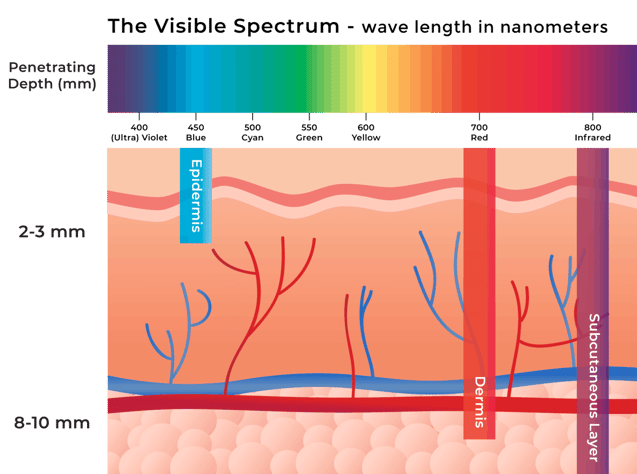IR (infrared) light is the light that just past the visible range to the human eye. Infrared light can be sectioned into 3 parts. Near-infrared, Medium Infrared and Far-infrared light. Near-infrared Light is the section that is closer to the range that the human eye can see.

How deep can Infrared light penetrate the skin?
Near-infrared light therapy is a safe and natural treatments you can administer in the comforts of your home. Near-infrared light treatment involve shinging light between 810nm to 850nm onto your skin. The light photons in this wavelength can penetrate all the way to the subcutaneous layer, pass through bone and dense connective tissue to interact with light-sensitive molecules.
What can infrared light do to the skin?
It energizes cells so that they can function more efficiently and perform better repair and regeneration hence promoting wound healing. It also activates antioxidant molecules that combat free radicals caused by environmental stress, thereby reduce inflammation.
What are the benefits of different LED color lights?
UV lights - benefits - boost vitamin D production, treat various skin disorders and multiple sclerosis. Need to use with caution due to it’s potential to damage cell’s DNA.
(Can you see it? No. It is not in the visible range of spectrum)
Blue lights - (wavelength 405-450nm) benefits - reaches the epidermis layer, has antibacterial effects in treating acne. Boosts cognitive functioning, alertness and memory. Help feels more energized.
(Can you see it? Yes, the wavelength in the visible range, our brain interprets it as blue)
Red lights (wavelength 625-660nm) - benefits -reaches the dermis layer, anti-aging, boost metabolism, improve nerve health, pain relief, promote hair growth etc.
(Can you see it? Yes, the wavelength is in the visible range, our brain interprets it as red)
NIR -(wavelength 800-900nm) benefits - reaches all the way to the subcutaneous layer, the light photons are able to pass through bone and dense connective tissue to interact with light-sensitive molecules. It energizes the cells so they are able to function more efficiently and perform better repair and regeneration.
(Can you see it? No, it’s not in the visible range though it it close to the Red)
What are the different wavelengths of different color LED lights?
Lights are not of specific wavelength but more of a band of wavelength. Human eye and brain perceive the different light wavelength as different colors.
.png?width=180&height=80&name=imgpsh_fullsize_anim%20(1).png)

